CONFESSIONS OF A WEAVER BELIEVER
A personal view of shooting stances through the history of Practical Shooting
I joined Aintree Pistol Club in 1974, and was issued my firearms certificate in April 1975. At about the same time a group of like-minded enthusiasts, who had been reading Colonel Cooper's “Guns & Ammo” columns, started a Practical section. We shot from a two-handed combat crouch which we had seen in numerous books, mags and movies. Colonel Cooper had just published his iconic “Cooper on Handguns” which became our Bible. Frustratingly, the book doesn't actually cover technique, and were continued under the misapprehension that our crouch was actually the elusive Weaver Stance.
 [Dirty Harry Stance]
[Dirty Harry Stance]Steve Jahme-Smith, who later succeeded the Colonel as President of IPSC, organized a series of monthly shoots, which he called "Advanced Combat Teams", Basically, a scenario based on the prolific terrorist outrages of the time, which had us enter a surprise situation as a two-man team, requiring tactics as well as shooting skills. This was, at the time, worthy of the title “advanced” and it would be years before others were doing anything like this.
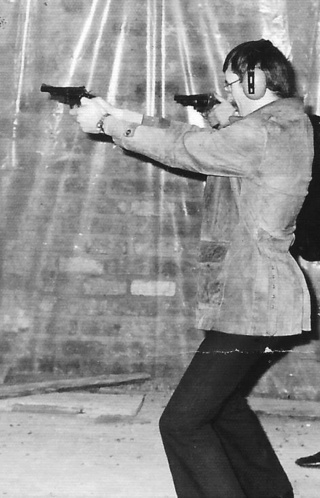 [Den Combat Crouch]
[Den Combat Crouch]My good friend John Clark had the keys to the range, and we regularly held informal daytime sessions were we tried all aspects of combat shooting, including pump-action shotgun work.
Another friend was Rod “Mac” McKinnerley, a local gunsmith, who was a stalwart of the practical group. Together we went down to Gravesend for a weekend, shooting a combat competition at Milton ranges; now taken over by the Met Police. This might well have been the first exchange competition.
Later in 1975 I took my first trip to RSA, and while there entered a combat competition at a range on the slopes of Table Mountain. At that time I was still using a .357 S&W Mod-19, but eventually saw the light and transitioned to a Colt .45 auto.
We were in touch with the nascent organization which later became formalized as the International Practical Shooting Confederation [IPSC] and heard about an upcoming World Championships in Berndorf, Austria. We entered a British Team comprised entirely of guys from Aintree Pistol Club.
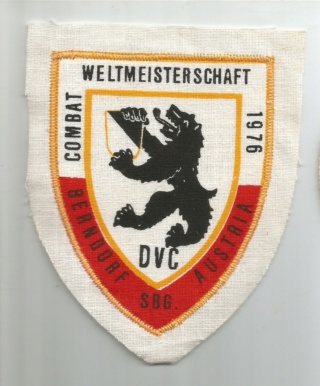
Although the match could best be described as semi-practical due to local range regulations, we met some great influences, including Colonel Cooper and Ray Chapman.
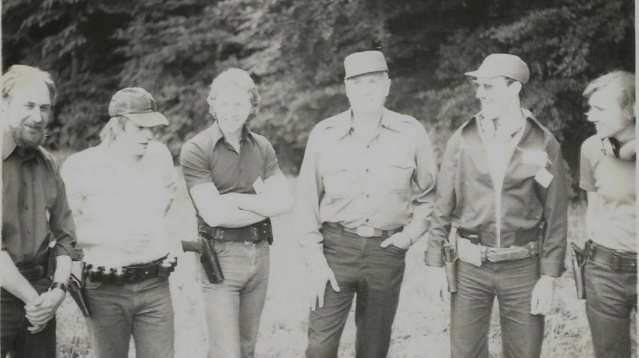 [British Team with Colonel Cooper]
[British Team with Colonel Cooper]At a get-together I got chatting to Gerry Gore, a very knowledgeable chap from South Africa. Gerry demonstrated the Weaver, explaining how it turned your upper body into a turret, and was analogous to shooting a rifle. This was my first exposure to the correct Weaver Stance, and was truly a “lightbulb moment”
Gerry was an interesting guy. His father served in the Cyprus police, and hosted Fairbairn. Gerry must be one of the few guys to have met and discussed shooting with both W.E. Fairbairn and Colonel Cooper.

I still have a signed copy of his book Handguns for Self-Defence A South African Guide
Following our first international comp combat shooting gradually spread in England, leading to the formation of the United Kingdom Practical Shooting Association [UKPSA] with Steve Jahme-Smith as Chairman, which was affiliated to IPSC.
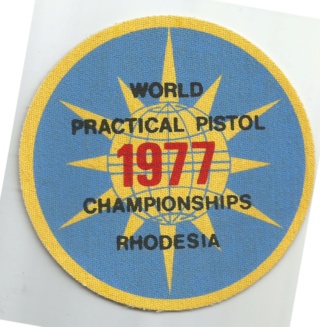 THE RATIONALE OF THE WEAVER STANCE.
THE RATIONALE OF THE WEAVER STANCE.Colonel Cooper had attended the FBI program at Quantico, which, like most others, restricted weapon type and shooting technique. Jeff wanted to find out what was really best, so created an open event, where all handguns were allowed, and the shooter could choose whatever technique he wished.
Initially, competitors primarily used some form of point shooting, a single-handed technique with the pistol fired from the hip, that was popular and believed to be the best-suited to the purpose. However, shooters would often discharge several rounds from the hip in rapid succession, but miss the 18-inch balloons seven yards away. One of the early champions, Jack Weaver, switched to an eye-level, two-handed, aimed technique. In his words, "a pretty quick hit was better than a lightning-fast miss." Jack won in 1960, and we can chart the rise of the Weaver Stance from that date.
Weaver's string of victories, resulting from his new method, influenced adoption of the technique and abandonment of point shooting. Soon, firearms trainers, most notably Cooper, began refining and codifying the concept; the result became the modern technique.
 [Variations on the Weaver Stance]
[Variations on the Weaver Stance]Over several years, the Bear Valley Gunslingers evolved into the South Western Combat Pistol League (SWCPL
How to do the "Weaver Stance": Stand with feet about shoulder-width apart and knees locked. Keep the foot on the side of your gun arm back from your other foot.
Step 1: Extend the hand holding the pistol out in front of you until your arm is almost fully extended. Keep a slight bend in the elbow. Hold your gun at shoulder level.
Step 2: Grip your gun hand with your other hand. Keep the elbow of that arm bent, held close to your body and pointed toward the floor. When firing, push forward with your gun arm and pull back with the other arm.
Step 3: Turn your body at a 45-degree angle to your target. Bend your head slightly to align the gunsight.
Arms should be fairly close together when employing the Weaver shooting stance. Do not allow your elbows to flare out from the body.
Control the recoil and improve shooting accuracy by remembering the push/pull action when firing in the Weaver stance. Straighten out your gun arm fully to employ the modified Weaver shooting stance that is becoming more popular today. Shooting accuracy may be lost when using the Weaver stance because the gun arm may overpower the support arm; thus, a right-handed shooter may pull shots to the right, and vice versa for a left-handed shooter.
 [Colonel Cooper demonstrating his Weaver]
[Colonel Cooper demonstrating his Weaver]In 1978 I attended the API-250 Course, presented by Jeff at Bisley Here all the techniques of the “Modern Technique” were explained in great detail.

At the time Weaver seemed state of the art. Jeff told us about the results that LAPD SWAT had achieved with the method.
Several official organizations adopted the Weaver, but only gradually. I had a friend who was an instructor with UK Special Forces. I showed Alan the Weaver, he was on range when an officer approached, saying “you shoot very well, but it's wrong” Fast forward to training with CP unit 1991, they were trumpeting Weaver as the great new thing!
 [The Colonel checks Den as he shoots a drill]
[The Colonel checks Den as he shoots a drill]In 1981 the FBI, who considered themselves the fount of knowledge, adopted the Weaver. As one wag put it “In 1981 the FBI were dragged kicking and screaming into the Sixties”
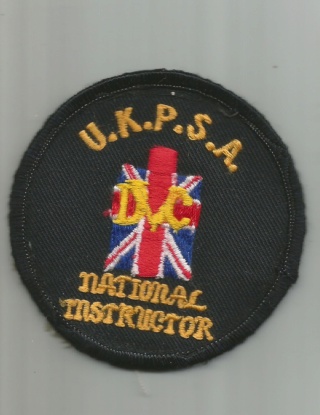
In about 1980 the UKPSA held there first Instructor Program at the prestigious Bisley ranges.. I attended, and was certified as a National Instructor. At Bisley I met Bruce Stevens, a part-time holster maker, who produced an excellent copy of the Nelson “Summer Special” I purchased one, and since then this internal-fit design, whether by Milt Sparks, Price-Western, Andy Aratoonian, or, Greg Kramer has been my predominant covert-carriage rig..
GAMESMENAt an overseas competition in the late Seventies I was going through the usual procedure of taking off my everyday carry holster and donning my “Comp rig”when I had one of those “lightbulb moments” Why was I using a different type of holster to compete, when IPSC was supposed to be about learning practical self-protection? From then on all my range work was done using my standard covert-carriage holsters, usually an internal-fit as mentioned, and always from a concealed state.

Although the original concept of the early matches at Big Bear, which were the fount of combat competition, Jeff Cooper admitted he had made a mistake in allowing unrestricted holsters. He wanted to find out what techniques, and equipment, worked best, but unfortunately this led to the development of “speed holsters” which were great for a particular comp, but impractical off the range.
After Colonel Cooper ended his term, Steve Jahme-Smith became IPSC President, and together with Jan Stevenson, an expatriate American firearms expert, now resident in the UK, began a move to adopt a holster rule, which would require all holsters to be concealable. After some quite shady back room political wrangling the rule was defeated, and the games continued. Steve and Jan, very honourably resigned from their positions. Jan went on to edit the excellent
Handgunner magazine in the UK.
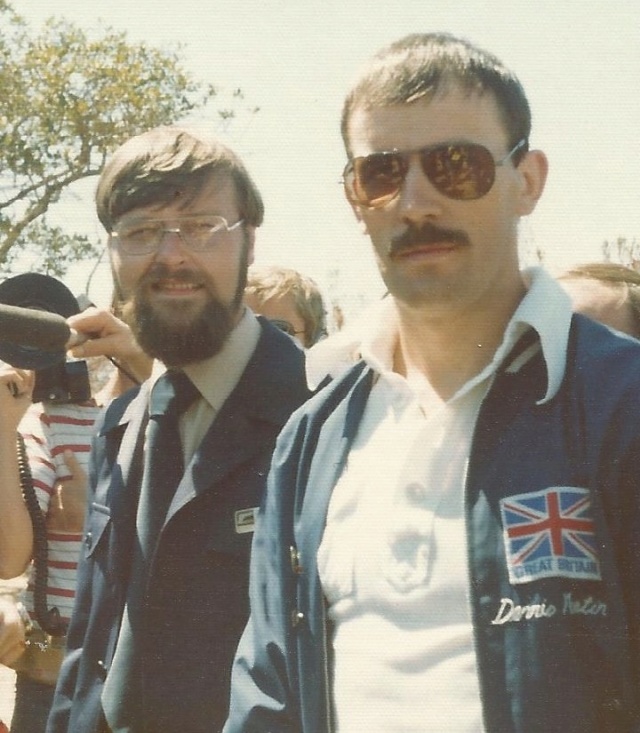 [Steve Jahme-Smith on left, with Den. Steve was one of the best match designers we had. Combat shooting owes him much]
[Steve Jahme-Smith on left, with Den. Steve was one of the best match designers we had. Combat shooting owes him much]This whole debacle was unfortunate, and unnecessary, because the same guys, those amazing shooters, who competed with comp-rigs would have dominated under concealed rules.
There were other aspects to IPSC which defied “combat logic” Although barricades and other cover-opportunities often adorn a stage, the use of cover was derisory.
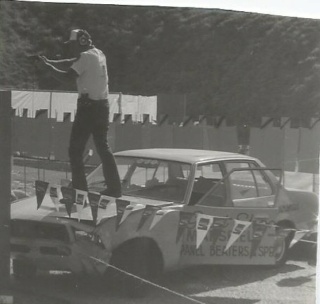 [Instead of using the vehicle for cover, competitors jumped on the hood, fully exposed to an array of targets]
[Instead of using the vehicle for cover, competitors jumped on the hood, fully exposed to an array of targets]There was also an increasing emphasis on reducing recoil [ported barrels etc], which led to the current “race guns” Red-dot sights, which were the size of telescopes, were mounted on the slide, which greatly assisted fast target acquisition, but made the weapon impractical for everyday carry.
The competitive drive resulted in an “arms war” with equipment being the battleground. This can be exemplified by the fact that World Pea Shooter Championships winner used a Laser sight!
A noted gun-writer attended a match and interviewed the top guys. He wrote “They explained why each type of sight had a particular advantage. As they talked I realised that not only did I not understand what they were talking about; but I did,'t want to understand”
As an example the great Jim Cirillo, of the famed NYPD Stakeout Unit attended an IPSC match. Instead of moving across a kill zone, he low crawled below a wall and took out the targets. He was slow, which put him right down the scorecard, but he was the only one who would have survived in reality. And that is what it all came down to; Games versus Reality.
I still trained at the range twice per week when I was home, and started creating “Tactical” shoots. In some ways we were getting back to what we had done at Aintree ACT events back in 1975, but with our equipment concealed.
Eventually a new activity was set up. The International Defensive Pistol Association [IDPA] emerged in 1996, just in time for the UK handgun ban. Curses! I have never shot an IDPA event, but had it been possible I would have been an enthusiastic member.
TRAINING AND MORE TRAINING
In 1988 Colonel Cooper returned to England, to present an Advanced Program at Essex. Terry and I attended. Terry struggled to contort his body-builder's arms into the Weaver, and the Colonel told him “Your prior physical training precludes you gaining any skill in pistol shooting” Wow! A couple of weeks later Mass Ayoob presented his first courses in England, and again Terry and I attended. Mass said to Terry “Don't like the Weaver, no problem, try extending your arms into the Isosceles” Terry, being a gifted athlete, took to the stance and shot very well. What a contrast in teaching styles..... fitting the man to the program, rather than fitting the program to the man.
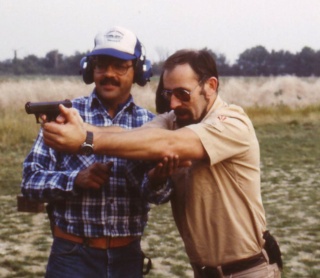 [Massad coached Den in the Stressfire Position, his version of the Isosceles]
[Massad coached Den in the Stressfire Position, his version of the Isosceles]Later the same year we presented our first US Bodyguard Program, in Detroit. A co-instructor was Evan Marshal, a victor of several gunfights, who emphasised use of cover over any particular technique. His priority to stay alive. Evan liked the Weaver, because it supported his favourite flashlight position, the Harries..
THE WEAKNESS OF THE WEAVERWe started to do quite a bit of scenario training, especially when training official Bodyguard teams. We used wax bullets, in the days before Simumitions, I started to notice that even experience proponents were failing to adopt the Weaver in stress situations. Similarly, we had been introduced to the Tueller Drill, and again saw the technique fail against a sudden charging attacker. Weaver worked well in predator mode [why SWAT liked it] but tended to fail in the stress of a sudden reactive situation
I gradually modified my stance, making it more square until at my first visit to the Federal Law Enforcement Training Centre [FLETC] 1993 the lightbulb went on. They had Donny Chastelaine there for a course and I watched his methods.
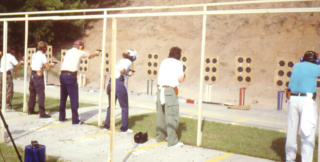 [FLETC Instructors taught by Donny Chastelaine]
[FLETC Instructors taught by Donny Chastelaine]I was hosted at FLETC by Warren Buttler, who had been a team-mate of Marcus with the Federal Air Marshals. Warren then showed me the stance and draw-stroke, and it made complete sense. I really wished I had listened to Mass Ayoob five years earlier!
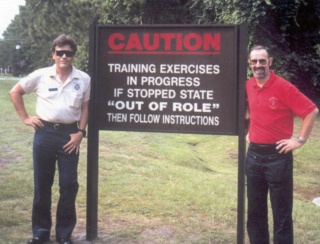 [Warren and Den at FLETC]
[Warren and Den at FLETC]THE MODERN ISOSCELES STRUCTURE
Why it is effective? Steven Hunter triangles gave this great summation in “Hot Springs”
We draw with one hand, clasp the other hand to the gun and grip hard, we concentrate on the sights, we lock our elbows until we’re nothing but triangles. We got a triangle of arms between ourself and the gun and a triangle of legs between ourself and the ground. The triangle is nature’s only stable form. We’re crouching a little because that’s what our body wants to do when we get scared. We aren’t relying on the ability of our mind to do fancy calculations under extreme pressure and we ain’t counting on our fingers to do fancy manoeuvrers when all’s they want to do is clutch up. Every goddamn thing we do is sure and simple and plain. Our motions are simple and pure. Most of all: front sight, front sight, front sight. That’s the drill. If you see the front sight you’ll win and survive, if you don’t, you’ll die.
 [My version of the Mod-Iso, limited by injuries to both elbows]
[My version of the Mod-Iso, limited by injuries to both elbows]The old isosceles, beloved of Dirty Harry was deficient because the weight was back on the heels, making successive shots problematic. With the “Modern-Isosceles” [Mod-Iso] the weight is committed forward, controlling recoil.
This from my lesson plan on the stance:
1] Pyramidal Base:
Stance width, length ("don't stand on a tightrope")...knees flexed as "shock-absorber". Able to move in any direction.
2] Body committent angle.
Aggressive position... ("ears in front of shoulders, shoulders ahead of hips") Chest curl , head and shoulders locked. Analogous to "Pushing a car"
3] Square on.
Erect biped mammals fight by squaring their torso to the threat. Use a position that feeds off this "hard wired" instinct.
4] Tracking.
Stance is the base for engaging sudden surprise threats over the entire arc, or, at any angle. .
5] THIRD EYE
The weapon follows eyes, so that as the eyes pick up a threat the muzzle is already locked on. This is termed the Third Eye concept.
6] ELEVATION
Change elevation by flexing the knees. Again, don't break hand/eye index, but access head/pelvis by use of the knees as "pistons".
THE MODERN DRAW STROKE

[Warren showing the high pec-index position which forms part of the draw, and is the close/retention position]
The high draw to pec index allowed the weapon to be driven to target in a straight line, rather then being raised into vision. The pec index allowed the extreme-close/retention shot, rather than a separate “Speed rock”
 [Despite learning the technique from the Colonel, the Speed Rock is inferior to the High-pec]
[Despite learning the technique from the Colonel, the Speed Rock is inferior to the High-pec]
Despite the label “modern” the stance is not new.
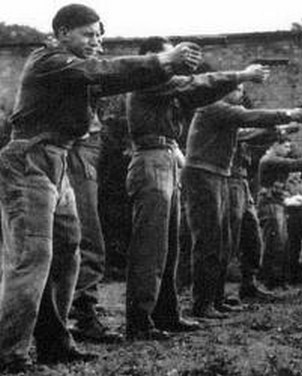 [OSS Jeds training in England during WW-2]
[OSS Jeds training in England during WW-2]Since adopting the Mod-Iso I have taught it on classes where guys are starting from scratch. For courses where the guys are already shooters I don't try to convert them. If they prefer Weaver, or some other system that's up to them. I explain the requisites of a stance for reactive situations then they can make their own evaluation I know from personal experience how resistant to change Weaver-believers can be. As Massad said “It's like de- programming Moonies!”
The whole thing about the Mod-iso is stability and aggression. As such it is ideal for CQB
CQB PISTOL TRAINING DEVELOPMENT
During WW-2 CQB was developed to a high level, mainly under the influence of W.E. Fairbairn. Unfortunately, once the war was over the military would typically return to "orthodox" shooting training methods. They prove very resistant to peacetime change .In law enforcement too, the majority of instruction was done by recreational shooters, who teach what they know. There were exceptions, some individual instructors based training on reality and were innovative, but in general, especially in the big agencies it was target shooting, one handed on manicured ranges. There will be guys serving now who started their firearms training that way.
Also, use-of-force training was heterogeneous. Pistol was taught separately from shotgun. Unarmed methods taught in another way, and impact weapons again taught apart from other force options.
 [Punch & Draw, transition between force options]
[Punch & Draw, transition between force options] [Shane demonstrates transition between weapons]
[Shane demonstrates transition between weapons]In more recent times, with crime rates rising, some switched-on instructors realised that such disparate training led to delays in decision-making, with sometimes fatal consequences. The solution was to integrate all the force options, all the tools, in a coherent system. They rediscovered CQB.
Tony Long, arguably the most experienced British firearms officer, said: “ Every worthwhile piece of material on the police use of firearms came out of the States and if they had all the experience, I wanted to learn from it.” To which I would add: “And everything that the Americans learned, they got from civilians. US police and military are very open to learning from outside sources, and many of those sources come from competitive shooting. The Tier One military Spec-Ops units send their personnel to be trained at civilian-run shooting schools.
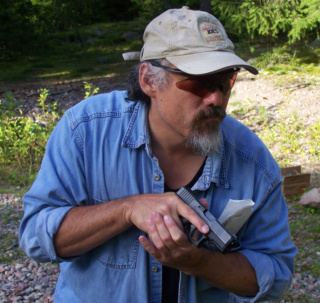 [Marcus made an invaluable contribution, with Neural based training.
[Marcus made an invaluable contribution, with Neural based training. Competition is the crucible of progress, and I must admit a large contribution has been made by those we termed “Gamesmen”
We have learned so much about shooting technique from high-level comps, not just the stance but all aspects of weapon manipulation, including malfunction drills.
It was demand from competition shooters that encouraged manufacturers to put decent, robust, high-visibility sights on our pistols. Those Red Dot sights, once the size of telescopes have become compact, allowing them to be practical for every day covert carriage.
For me it has been a long and enjoyable journey. Although my focus has always been on training for self-protection, I have also had a lot of fun on range. Shooting allowed me to meet a great group of people, many of who have become lifelong friends.
Changing techniques was a change for the better, because it emphasised to me that "training is about change" Also, I examined my beliefs, and why I was attached to various techniques and theories. Belief change can be a very powerful teaching tool, but that is for a another article.
LINKSCooper on HandgunsArticle on Jack WeaverThe Modern Technique of the PistolHandguns for Self Defence by Gerry GoreHot Springs by Steven HunterLethal Force by Tony LongThe Armed Option by Warren ButtlerHandgun Combatives by Dave SpauldingRatten krieg by Bob TaubertGunfighting by Scotty ReitzCombat Hangunnery by Mass AyoobInternational Defensive Pistol Association